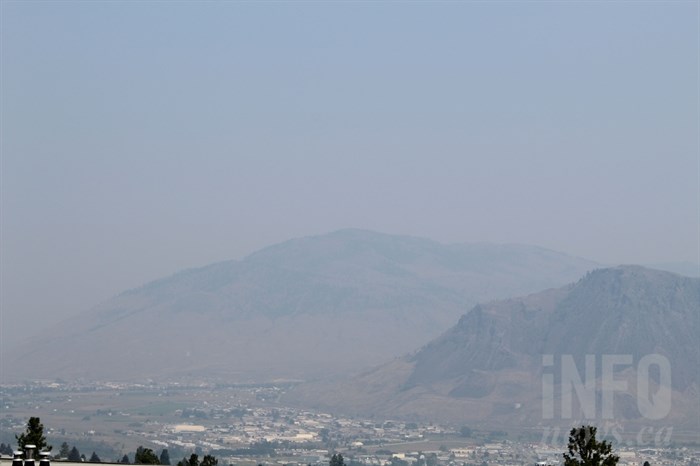
Smoke from forest fires near Kamloops in 2018.
Image Credit: FILE PHOTO
July 06, 2021 - 7:30 AM
During any forest fire season in the Kamloops Forest District – which includes the Okanagan – air quality advisories are almost as common as evacuation advisories.
But, figuring out the difference between the air quality ranking versus things like PM2.5 and PM10 is not necessarily simple.
Even without a number to put to things, the advice is to pay attention to how you feel.
“Everyone is going to react differently,” Annie Seagram, air quality meteorologist with the Ministry of Environment told iNFOnews.ca. “You might have a sore throat, you might notice your eyes get itchy, your nose gets itchy. You can react even to low levels. Pay attention to how you’re feeling. React to how you’re feeling. If you feel like your throat is scratchy from being outside, then reduce your time outside.”
The Ministry posts the basic Air Quality Health Index online here.
That ranks air quality from one to 10, with the lower numbers indicating the lowest risks to health.
Rankings of one to three, in the low range, are described as: “Ideal air quality for outdoor activities.”
Moderate air quality rankings of four to six suggests strenuous outdoor activities should be restricted if you are experiencing symptoms such as coughing or throat irritation.
High is the seven to 10 range. Again, reduce strenuous outdoor activities only if you have symptoms it suggests children and the elderly, in particular, should take it easy.
The Very High ranking simply refers to anything above 10 where strenuous outdoor activities should be avoided. There are no numbers shown above 10, just the notation of 10+.
On the map, users can click on a location to get the reading in or near their city. The Okanagan, for example, is simply broken down into North, Central and South.
The map also allows for a deeper dive into particulate matter, ozone, nitrogen dioxide and sulphur dioxide, which are the five elements used to create the air quality index.
The key indicator to look at during fire season is particulate matter, of which there are two classifications.
PM10 measures particles larger than 10 micrometres which are triggered by things like dust. The PM2.5 particles are smaller (2.5 micrometres and smaller) and come from fires and industrial pollutants.
They are so small (a micrometre is about the size of a human hair so a PM2.5 particle is 1/30th of that) that they can get into the lungs and even into the blood.
The Ministry of Environment’s objective is to have a 24-hour average of 25 micrometres of PM2.5 or less. But comparing daily averages doesn’t take into account that, with new fires starting and winds shifting, the air quality is quite volatile so current conditions may vary widely.
A random reading for Kamloops, for example, showed a PM2.5 reading of 41.6 over the previous 24 hours but a one-hour reading of 54.7. That’s at a time when the air quality index for the city was at six, still in the moderate range.
The same chart shows the PM2.5 moderate ranking as 40-60 micrometres. It’s rated as high risk between 60 and 250.
Seagram suggested checking both indexes before planning strenuous outdoor activities.
“It’s pretty hard to predict,” she said. “Within the hour it can really change. It’s a very dynamic situation.”
To contact a reporter for this story, email Rob Munro or call 250-808-0143 or email the editor. You can also submit photos, videos or news tips to the newsroom and be entered to win a monthly prize draw.
We welcome your comments and opinions on our stories but play nice. We won't censor or delete comments unless they contain off-topic statements or links, unnecessary vulgarity, false facts, spam or obviously fake profiles. If you have any concerns about what you see in comments, email the editor in the link above.
News from © iNFOnews, 2021